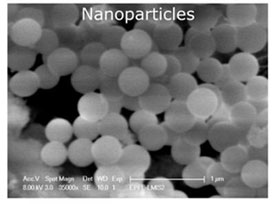Researchers at Ecole Polytechnique Federale de Lausanne (EPFL) have reported a new procedure that has produced "Pyrex"-like nanoparticles.
Currently most nanoparticles are made of polymers or silica glass. Because of the large surface-to-volume ration, nanoparticles have generated wide interest as potential transporters of antibodies, drugs, or chemicals for use in diagnostic tests, targeted drug therapy, or for catalyzing chemical reactions. 
Borosilicate glass nanoparticles. (Photo: Martin Gijs, EPFL)
Unfortunately, many of these applications are limited because the nanoparticles disintegrate or bunch together when exposed to elevated temperatures, certain chemicals or even de-ionized water.
However, this group of researchers, led by EPFL professor Martin Gijs, have reported a new procedure to fabricate and characterize borosilicate glass nanoparticles. Used in microfluidic systems, these Pyrex-like nanoparticles are more stable when subjected to temperature fluctuations and harsh chemical environments.
According to the researchers at EPFL, this new technology could extend the range of potential nanoparticle applications in biomedical, optical and electronic fields, as well as applications in the production of photonic bandgap devices for ultrasonic microscopy or chemical filtration membranes.
For more information, visit: www.epfl.ch